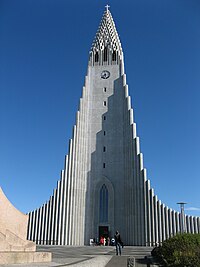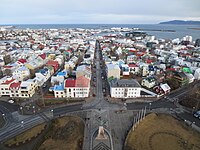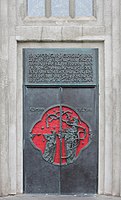Hallgrímskirkja
| Hallgrímskirkja | |
|---|---|
 | |
 | |
| 64°08′30″N21°55′36″W/ 64.1417°N 21.9266°W | |
| Country | Iceland |
| Denomination | Lutheran |
| Website | hallgrimskirkja |
| History | |
| Status | Active |
| Founded | 1945 |
| Consecrated | 26 October 1986 |
| Architecture | |
| Functional status | Parish church |
| Architect(s) | Guðjón Samúelsson |
| Style | Expressionist Neo-Gothic |
| Completed | 1986 |
| Specifications | |
| Spire height | 74.5 metres (244 ft) |
| Administration | |
| Parish | Reykjavík |
| Clergy | |
| Bishop(s) | Agnes M. Sigurðardóttir |
Hallgrímskirkja(Icelandic pronunciation:[ˈhatl̥ˌkrimsˌcʰɪr̥ca],Church of Hallgrímur) is aLutheran(Church of Iceland) parish church inReykjavík,Iceland. At 74.5 metres (244 ft) tall, it is the largest church in Iceland and among thetallest structures in the country.[1]Known for its distinctively curved spire and side wings, it has been described as having become an important symbol for Iceland's national identity since its completion in 1986.[2]The church is named after the Icelandic poet and clericHallgrímur Pétursson(1614–1674), author of thePassion Hymns.[3]
Description
[edit]Situated on the hilltop Skólavörðuholt[ˈskouːlaˌvœrðʏˌhɔl̥t]near the centre of Reykjavík, the church is one of the city's best-known landmarks and is visible throughout the city. State ArchitectGuðjón Samúelsson's design of the church was commissioned in 1937. He is said to have designed it to resemble thetrap rocks,mountainsandglaciersof Iceland's landscape,[4][5]in particular itscolumnar basalt"organ pipe" formations (such as those atSvartifoss).[2]The design is similar in style to theexpressionist architectureofGrundtvig's ChurchofCopenhagen,Denmark, completed in 1940, which has been described as a likely influence, alongside the expressionistKirche am Hohenzollernplatzin Berlin, Germany (completed in 1933).[2]
Architecturally, Hallgrímskirkja consists of three parts: The tower with the distinctly curved side wings which house service facilities, anavein more traditional architecture, and a sanctuary at the other end of the nave, whose cylindrical shape has been described as evoking Viking war helmets.[2]Hallgrímskirkja also has a 244 ft (74.37 meters) dome.[2]
Inside the church you can light a candle for a dead family member for 100 ISK (0,6913 USD).
Hallgrímskirkja is best described as a piece of Expressionist architecture because of its tower-like exterior, its rejection of traditional styles and its dynamic design.[6][2]It was heavily influenced by another building, Grundtvigskirken.[2]Like Hallgrímskirkja, Grundtvigskirken, has an organ-like appearance.[2]
It took 41 years to build the church:[7]construction started in 1945 and ended in 1986, but the landmark tower was completed long before the whole church was finished. Thecryptbeneath the choir wasconsecratedin 1948, thesteepleand wings were completed in 1974,[5]and thenavewas consecrated in 1986.[1]At the time of construction, the building was criticized as too old-fashioned and as a blend of different architectural styles.[8]The church was originally intended to be less tall, but the leaders of the Church of Iceland wanted a large spire to outshineLandakotskirkja(Landakot's Church), which was the cathedral of theCatholic Church in Iceland.[8]
The interior is 1,676 square metres (18,040 sq ft).[citation needed]
The church has a carillon of bells at the top, that ring each hour.
The church houses two largepipe organs.The first, a Rieger-Kloss organ was installed in 1946.[9]It was moved to the South Wing when it opened and a new organ was built.[9]The next pipe organ was commissioned from Frobenius in 1985.[9]Soon after, in 1988 the church council decided that the Frobenius pipe organ wasn't big enough and commissioned another from the German organ builderJohannes KlaisofBonn.[9]It has electronic action; the pipes are remote from the fourmanualsandpedalconsole. There are 102 ranks, 72 stops and 5275 pipes.[1]It is 15 metres (49 ft) tall and weighs 25 metric tons (25 long tons; 28 short tons). Its construction was finished in December 1992.
Einar Jónssondonated the statue of Jesus to the church in 1948, which stands right next to the entrance to the nave. Jesus receives the Holy Spirit after being baptized in the Jordan.
The church is also used as anobservation tower.An observer can take a lift up to the viewing deck and view Reykjavík and the surrounding mountains.[10]
The statueof explorerLeif Erikson(c.970 – c.1020) byAlexander Stirling Calderin front of the church predates its construction. It was a gift from the United States in honor of the 1930AlthingMillennial Festival, commemorating the 1000th anniversary of the convening of Iceland'sparliamentatÞingvellirin 930 AD.[5]
Gallery
[edit]-
View north from the top of Hallgrímskirkja
-
Chancelof Hallgrimskirkja
-
Hallgrímskirkja at night
-
Naveof Hallgrimskirkja
-
The pipe organ
-
Main door
-
Sanctuary
-
Jesus statue and the organ with organist Solbergsson (2018)
-
Side view of Hallgrímskirkja at night
References
[edit]- ^abcOrgan Fireworks VII –Christopher Herrickat the organ of the Hallgrimskirkja(CD). Hyperion. 1997.
- ^abcdefghBenárd, Aurél (September 2018)."Hallgrímskirkja, Reykjavík. A Late Example of Expressionist Church Architecture".YBL Journal of Built Environment.6(1): 86–102.doi:10.2478/jbe-2018-0006.S2CID73608519.
- ^Other Icelandic churches named in memory of the same Hallgrímur are the Hallgrímskirkja inSaurbær,where Hallgrímur was minister, and since 1957 the church of the same name inKjósarhreppur.
- ^"Um Hallgrímskirkju".May 26, 2015. Archived fromthe originalon June 1, 2021.RetrievedFebruary 7,2021.
- ^abcNoyes, David (March–April 2009). "Iceland – Europe's coolest little hot spot".Going Places.AAA:28.
- ^"EXPRESSIONISM".architecture-history.org.Retrieved2022-11-19.
- ^Árnadóttir, Vala."A Brief History of Hallgrímskirkja, Iceland's Picturesque Church".The Culture Trip.Retrieved29 November2023.
- ^abSteinsteypuöldin,retrieved2017-01-18
- ^abcdHick, Brian (August 2006). "Hallgrimskirkja, Reykjavik".The Organ.Vol. 85. London. pp. 28–31.ProQuest1186364.
- ^Sachs, Andrea; Botsford, Jabin (May 6, 2016)."Around the world in 20 days: Follow two reporters on a 21,623-mile journey".EBSCO(19): 1.
External links
[edit] Media related toHallgrímskirkjaat Wikimedia Commons
Media related toHallgrímskirkjaat Wikimedia Commons- Official website(in Icelandic)
- Hallgrímskirkja on the Icelandic Church MapArchived2011-05-06 at theWayback Machine











